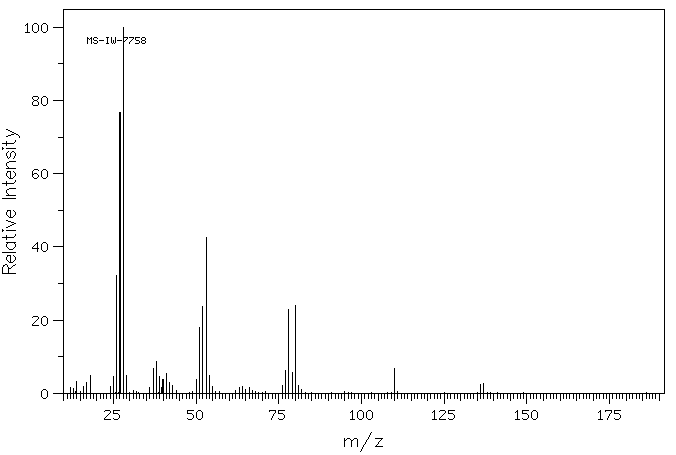tetrazolo[1,5-b]pyridazin-6-ylamine | 19195-43-8
中文名称
——
中文别名
——
英文名称
tetrazolo[1,5-b]pyridazin-6-ylamine
英文别名
6-Amino-tetrazolo<1,5-b>pyridazin;6-Amino-tetrazolo<1.5-b>pyridazin;6-Aminotetrazolo(1,5-b)pyridazin;Tetrazolo[1,5-b]pyridazin-6-amine
CAS
19195-43-8
化学式
C4H4N6
mdl
MFCD03001632
分子量
136.116
InChiKey
FCBRQZIPVWCKKL-UHFFFAOYSA-N
BEILSTEIN
——
EINECS
——
-
物化性质
-
计算性质
-
ADMET
-
安全信息
-
SDS
-
制备方法与用途
-
上下游信息
-
文献信息
-
表征谱图
-
同类化合物
-
相关功能分类
-
相关结构分类
计算性质
-
辛醇/水分配系数(LogP):-0.5
-
重原子数:10
-
可旋转键数:0
-
环数:2.0
-
sp3杂化的碳原子比例:0.0
-
拓扑面积:82
-
氢给体数:1
-
氢受体数:5
SDS
上下游信息
-
上游原料
中文名称 英文名称 CAS号 化学式 分子量 —— 6-azide-1,2,3,4-tetrazolo<1,5-b>pyridazine 14393-79-4 C4H2N8 162.113 6-氯四唑并[1,5-b]吡嗪 6-chloro-1,2,3,4-tetrazolo<1,5-b>pyridazine 21413-15-0 C4H2ClN5 155.546
反应信息
-
作为反应物:描述:参考文献:名称:Duplex Molecular Strands Based on the 3,6-Diaminopyridazine Hydrogen Bonding Motif: Amplifying Small-Molecule Self-Assembly Preferences through Preorganization and Iterative Arrangement of Binding Residues摘要:Structural parameters obtained through single-crystal X-ray diffraction analysis of the one-dimensional H-bonding motif expressed by 3,6-diaminopyridazine are applied to the design of related monomeric, dimeric, and trimeric duplex molecular strands. The mode of assembly and the interstrand affinity of the oligomers are established in solution by H-1 NMR dilution experiments, isothermal titration calorimetry (ITC), and vapor pressure osmometry. Single-crystal X-ray crystallographic analysis of the dimeric diaminopyriclazine 2a corroborates the intended duplex mode of assembly. Binding free energy per unimer (-DeltaGdegrees/n) increases upon extension from monomer to dimer to trimer, signifying a positive cooperative effect. Micromolar binding affinity (K-d = 1.25 +/- 0.1 muM) was determined for the duplex trimer by ITC in 1,2-dichloroethane at 20degreesC. These data provide further insight into the structural and interactional features of synthetic duplex oligomers required for high-affinity, high-specificity binding and define new recognition elements for use in nanoscale assembly.DOI:10.1021/ja044566p
-
作为产物:描述:6-azide-1,2,3,4-tetrazolo<1,5-b>pyridazine 在 Molybdenum(III) Reagent 作用下, 以 四氢呋喃 、 水 为溶剂, 反应 0.25h, 以66%的产率得到tetrazolo[1,5-b]pyridazin-6-ylamine参考文献:名称:Selective Reduction of Heterocyclic Azides and Hydrazino Compounds to Amines by Molybdenum(III) Species摘要:DOI:10.1055/s-1980-29225
文献信息
-
POLANC S.; STANOVNIK B.; TISLER M., SYNTHESIS, 1980, NO 10, 830-831作者:POLANC S.、 STANOVNIK B.、 TISLER M.DOI:——日期:——
-
STANOVNIK B.; TISLER M.; POLANC S.; GRACNER M., SYNTHESIS <SYNT-BF>, 1978, NO 1, 65-66作者:STANOVNIK B.、 TISLER M.、 POLANC S.、 GRACNER M.DOI:——日期:——
表征谱图
-
氢谱1HNMR
-
质谱MS
-
碳谱13CNMR
-
红外IR
-
拉曼Raman
-
峰位数据
-
峰位匹配
-
表征信息
同类化合物
(S)-3-(2-(二氟甲基)吡啶-4-基)-7-氟-3-(3-(嘧啶-5-基)苯基)-3H-异吲哚-1-胺
(6-羟基嘧啶-4-基)乙酸
(4,5-二甲氧基-1,2,3,6-四氢哒嗪)
鲁匹替丁
马西替坦杂质7
马西替坦杂质4
马西替坦杂质
马西替坦原料药杂质D
马西替坦原料药杂质B
马西替坦
顺式-4-{[5-溴-2-(2,5-二甲基-1H-吡咯-1-基)-6-甲基嘧啶-4-基]氨基}环己醇
非沙比妥
非巴氨酯
非尼啶醇
青鲜素钾盐
雷特格韦钾盐
雷特格韦相关化合物E(USP)
雷特格韦杂质8
雷特格韦EP杂质H
雷特格韦-RT9
雷特格韦
阿西莫司杂质3
阿西莫司
阿脲四水合物
阿脲一水合物
阿维霉素
阿米美啶
阿米洛利
阿米妥钠
阿洛巴比妥
阿普瑞西他滨
阿普比妥
阿巴卡韦相关化合物B(USP)
阿卡明
阿伐那非杂质V
阿伐那非杂质1
阿伐那非杂质
阿伐那非中间体
阿伐那非
铂(2+)二氯化6-甲基-1,3-二{2-[(2-甲基丙基)硫烷基]乙基}嘧啶-2,4(1H,3H)-二酮(1:1)
钴1,2,3,6-四氢-2,6-二氧代嘧啶-4-羧酸酯(1:2)
钠5-烯丙基-4,6-二氧代-1,4,5,6-四氢-2-嘧啶醇酸酯
钠5-乙基-4,6-二氧代-1,4,5,6-四氢-2-嘧啶醇酸酯
钠5-(2-溴丙-2-烯基)-5-丁烷-2-基-4,6-二氧代-1H-嘧啶-2-醇
醌肟腙
酒石酸噻吩嘧啶
那可比妥
辛基2,6-二氧代-1,2,3,6-四氢-4-嘧啶羧酸酯
赛乐西帕杂质3
赛乐西帕KSM3








